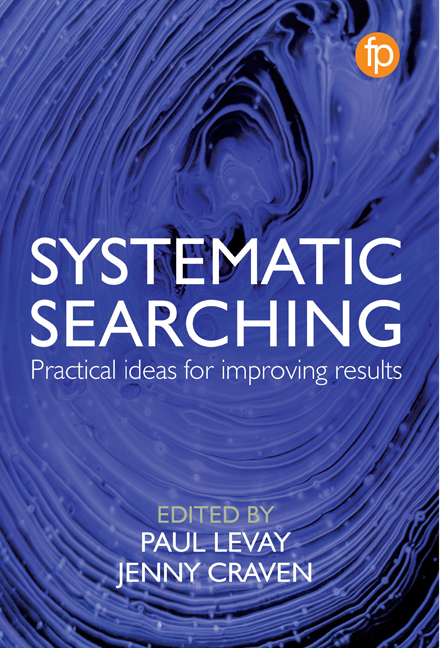Book contents
- Frontmatter
- Contents
- Figures, tables and case studies
- Contributors
- Acknowledgements
- Abbreviations
- Foreword
- 1 Introduction: where are we now?
- 2 Innovative approaches to systematic reviewing
- 3 Searching for broad-based topics
- 4 Choosing the right databases and search techniques
- 5 Gathering evidence from grey literature and unpublished data
- 6 Social media as a source of evidence
- 7 Text mining for information specialists
- 8 Using linked data for evidence synthesis
- 9 Evidence surveillance to keep up to date with new research
- 10 Training the next generation of information specialists
- 11 Collaborative working to improve searching
- 12 Communication for information specialists
- 13 The information specialist as an expert searcher
- 14 Conclusion: where do we go from here?
- Glossary
- Index
8 - Using linked data for evidence synthesis
Published online by Cambridge University Press: 08 June 2019
- Frontmatter
- Contents
- Figures, tables and case studies
- Contributors
- Acknowledgements
- Abbreviations
- Foreword
- 1 Introduction: where are we now?
- 2 Innovative approaches to systematic reviewing
- 3 Searching for broad-based topics
- 4 Choosing the right databases and search techniques
- 5 Gathering evidence from grey literature and unpublished data
- 6 Social media as a source of evidence
- 7 Text mining for information specialists
- 8 Using linked data for evidence synthesis
- 9 Evidence surveillance to keep up to date with new research
- 10 Training the next generation of information specialists
- 11 Collaborative working to improve searching
- 12 Communication for information specialists
- 13 The information specialist as an expert searcher
- 14 Conclusion: where do we go from here?
- Glossary
- Index
Summary
Introduction
Information has long been captured and shared using documents. The success of the internet, and in particular the world wide web, in enabling the rapid and far-reaching sharing of information is undeniable and it has done this largely through sharing digital documents. Finding the right information in this ever-growing sea of documents has always been a challenge. The use of labels and categories to group documents by their subject matter offers some assistance. The use of search engines that can trawl through many of these documents on our behalf is also an important tool. However, where we have more and more information and less and less time to search and sift through it, we often do not have the luxury of reading through many books or documents to find the information we need. We need to identify with greater precision the relevant and trust - worthy knowledge and do it more quickly. This requires capturing our knowledge in a different way and so we need to go beyond documents and think more about the ‘things’ (such as concepts, ideas and knowledge) captured within the documents.
A common language is essential when sharing information, whether it is a spoken language between two people or a digital message sent between two computers. To make a language common then both parties must understand the structure of the sentences and the meaning of the words; the syntax and the semantics. When trying to arrive at a standard way of using language in the digital world we often make use of ontology (Uschold and Gruninger, 1996).
The field of ontology has its roots in philosophy, in the understanding and classification of all things. In this context, ontologies are often only judged true ontologies if they successfully describe unchanging aspects of the world. Fascinating as this may be, it is an enormous field in its own right and is therefore not the focus of this chapter. From an information management and computer science perspective, ontology development has taken on a more pragmatic purpose. Here, many of the same principles and methods are used to capture definitions of things by understanding their properties and how they relate to other things.
- Type
- Chapter
- Information
- Systematic SearchingPractical ideas for improving results, pp. 171 - 188Publisher: FacetPrint publication year: 2018

